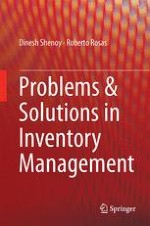2018 | OriginalPaper | Buchkapitel
2. Inventory Control Systems: Design Factors
verfasst von : Dinesh Shenoy, Roberto Rosas
Erschienen in: Problems & Solutions in Inventory Management
Aktivieren Sie unsere intelligente Suche, um passende Fachinhalte oder Patente zu finden.
Wählen Sie Textabschnitte aus um mit Künstlicher Intelligenz passenden Patente zu finden. powered by
Markieren Sie Textabschnitte, um KI-gestützt weitere passende Inhalte zu finden. powered by
Abstract
-
Continuous Review, Fixed Order Quantity (s, Q) System
-
Continuous Review, Order-Up-to-Level (s, S) System
-
Periodic Review, Order-Up-to-Level (T, S) System
